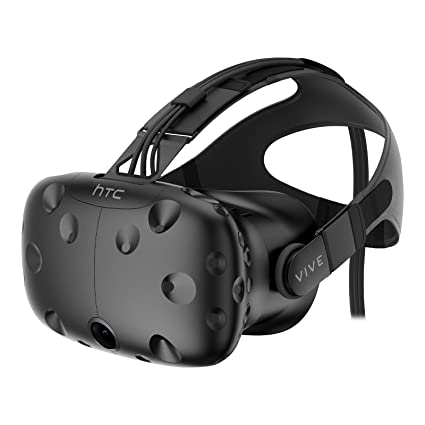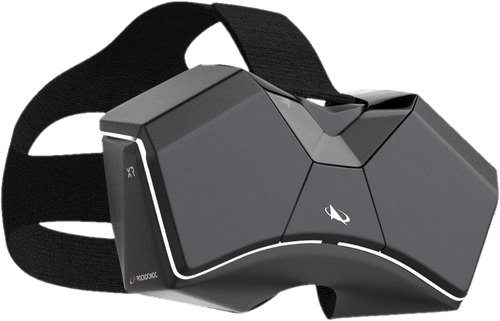HTC VIVE vs Roscosmos XR-2
When you compare the HTC VIVE to the Roscosmos XR-2 you can see which VR Headset is better. Let's take a look of the comparison, and see which model of VR Headset out ontop.
 HTC VIVE
HTC VIVE4.3
Based on 3 reviews
Lowest prices
What VR Headset is better?
Comparing the HTC VIVE and Roscosmos XR-2 Virtual Reality Headsets
The VR market is quickly evolving with new headsets becoming available on a regular basis. In this comparison, I am looking at the HTC VIVE and the Roscosmos XR-2 headsets. Both are PC VR headsets but there are significant differences between them that could make one a better choice than another depending on what you need in a headset.
Starting with their Field of View (FOV), the VIVE has an FOV of 110° while the XR-2 has an impressive 157° FOV, making it considerably wider than the VIVE’s FOV. This can make for more immersive experiences as a larger field of view allows users to see more detail in their surroundings when using VR applications. The higher resolution of 5760 x 2800 px that comes with the XR-2 also adds to its immersive experience as well as making visuals look much sharper and clearer than those produced by the Vive’s 1080 × 1200 px resolution. This makes it great for gaming or any other type of virtual reality application where clear visuals are important.
In terms of minimum specs required, both require high end computers to run optimally but they have different specifications needed in order to do so effectively. The Vive requires an Intel I5-4590 or AMD FX 8350 processor along with either an Nvidia GeForce™ GTX 1060 or AMD Radeon™ RX 480 graphics card while the XR-2 only needs an Intel i7 processor or equivalent along with 8GB RAM and 3 GB video memory which is significantly less demanding compared to what's needed for the Vive.
Regarding motion tracking technology, both headsets use room scale 360 tracking which allows users to move freely in their environment without worrying about getting out of range from tracking sensors since these technologies allow for greater freedom of movement within any given space regardless if you're standing up, sitting down, kneeling or even crouching down close to floor level when playing games or exploring virtual environments in your VR experiences. However, one major difference here is that the refresh rate on each headset differs greatly - 90 Hz on Vive vs 120 Hz on XR-2 - which means that movement will feel smoother and visuals more detailed on XR-2 compared to Vive due its higher refresh rate capabilities meaning players can enjoy even better gameplay experiences with less noticeable lag when turning around suddenly etc..
Finally, another important thing worth noting here is that while both headsets work out of box with Windows operating system only ,the Roscosmos XR-2 also supports Linux which may be beneficial for certain users who prefer using this OS instead so they won't have any issues setting up their device regardless what OS they're running at home .
After having used both headsets personally I found that while they offer different levels visual fidelity and overall performance depending whether your budget allows you buy either headset or not ,the key takeaway here was how great these two devices made me feel when wearing them no matter if we talk about comfort level thanks wide FoV providing very immersive experience because all you can notice were colors ,textures & details captured by dual cameras mounted front panel coupled together into single ultra wide display projecting sharp images onto my eyes . It's truly amazing experience being able to play various games such as Beat Saber , Superhot & many others without worrying latency related problems ruining fun factor yet allowing enough time respond accordingly way possible due smooth frame rates along lack motion blur preventing nausea feeling after prolonged sessions . Even though Vive offers good performance set against lower price tag compared Roscomos' offering ,Xr 2 still wins hands down thanks addition features like support Linux based operating systems few extra frames per second delivered delivering further increase visual quality plus superior comfort during extended playtimes .
Overall I would give my personal preference towards Roscomos XR 2 over HTC Vive mainly because higher price tag justifies increased performance showcased throughout whole product line therefore eliminating possibility running low quality apps missing best parts vr titles experienced via latest generation devices . What matters most however opinion whether upgrading older model worth investment regarding individual taste although second device seems quite promising judging sheer power delivered nothing short “wow” moments during session !
Specs comparison between the two VR Headsets
| HTC VIVE | Roscosmos XR-2 | |
|---|---|---|
| Overview | ||
| Brand | HTC | Roscosmos |
| Model Name | VIVE | XR-2 |
| Release Date | 2016 | |
| Country of Origin | Taiwan | Russia |
| Category | PC VR | PC VR |
| Battery Life | 2.5 h | |
| Display | ||
| Field of View | 110° | 157° |
| Resolution | 1080 × 1200 px (per eye) | 5760 x 2800 px |
| Refresh Rate | 90 Hz | 120 Hz |
| Display Type | OLED | LCD |
| Minimum Requirements | ||
| Min. CPU Required | Intel I5-4590 or AMD FX 8350 | |
| Min. Graphics Required | Nvidia GeForce™ GTX 1060 or AMD Radeon™ RX 480 | |
| Min. RAM Required | 4 GB | |
| Operating Systems | Microsoft Windows | Microsoft Windows,Linux |
| Sizing | ||
| Weight | 470 g | |
| Dimensions | 199 × 122 × 122 mm | |
| Features | ||
| Room Scale? | YES | YES |
| 360 Tracking? | YES | YES |
| Positional Tracking? | YES | |
| Front Camera? | YES | |
| Eye Tracking? | YES | |
| Usable with Glasses? | YES | |
| Cooling System | No | |
| Built in Headphones? | No | |
| Built in Microphone? | YES | |
| Flip Visor? | YES | |
| Voice Command? | YES | |
| IPD Adjustment? | YES | |
| Lens to Eye Adjustment? | YES | |
| USB? | YES | YES |
| MicroUSB? | No | |
| Display Port? | YES | |
| Mini Display Port? | No | YES |
| HDMI? | YES | |
| MicroSD? | YES | |
| Bluetooth? | YES | |
| Wifi? | YES | |
